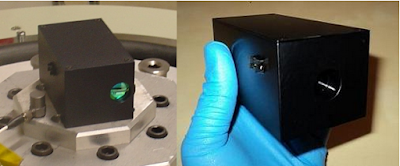Both moons are covered in a thick layer of dust. Due to their proximity, Mars, Deimos, and Phobos exchange this dust as ejecta when one body is impacted. The amount of dust exchanged is not known, but a careful investigation of Phobos's regolith may reveal information about Mars's history that cannot be found even at Mars. Phobos's trailing face receives large amounts of dust from Deimos. Due to the moons' small orbits, most ejecta thrown off a moon will return to it, although usually on the opposite side of the moon, spreading it rather evenly.
Very few surface features of Deimos are known, both because it is smoother due to a thicker layer of dust, and because fewer missions have taken pictures of it. The only remarkable feature is a large concavity in its south hemisphere. Only two craters, Voltaire and Swift, are named.
 |
| Credit: NASA |
Phobos is pretty cool. Both moons have a layer of light dust at least a few meters thick, but Phobos's layer is thinner, so craters and other features are not "muted" as those on Deimos are. It is also closer to Mars, so it is in a more dynamic environment, taking more impacts from ejecta thrown off of Mars and undergoing larger tidal stresses.
Phobos's most obvious surface feature is Stickney Crater. Stickney Crater is massive, about nine kilometers in diameter. Keep in mind, Phobos itself is only two to three times wider! Learning more about Stickney is crucial to learning more about Phobos, as the Stickney impact event shaped Phobos as we see it today. The impact nearly shattered the moon, and sent it spinning for about 14,000 years. In fact, there is evidence that Phobos's original orientation was opposite its current orientation - the impact flipped Phobos! The impact also coated all of Phobos with a layer of ejecta over a meter thick. There is some debate over the age of Stickney crater, as different methods suggest drastically different ages, and more information is needed to determine its true age.
 |
| Credit: NASA |
Stickney Crater is a promising site for future exploration, including crewed missions, as it would shield crews from radiation*.
Stickney's northwestern rim displays landslide features, which are an obvious dynamic process that can teach us about Phobos's development, and unearth fresher regolith that would ordinarily be buried. These landslides may also be hazards that need to be investigated before a crewed mission, as the severity and extend of landslides is unknown.
 |
| Credit: NASA |
Both moons are very dark, about as reflective as asphalt. However, in the near infrared spectrum, colors can be discerned. The moons' dust layer is largely reddish, but a region within and east of Stickney crater known as the "bluish" unit is, significantly less red. This region is likely excavated regolith, and investigating the interaction between the color units may help clarify Phobos's interior composition; whether Phobos is primarily "blue", with a thin layer of "red" on the surface, or a mix of "blue" and "red" blocks.
| Credit: Brown University |
 |
| Credit: Journal of Geophysical Research |
 |
| Credit: Brown University |
Phobos is strewn with large boulders called ejecta blocks, most of which are thought to have been thrown up by the Stickney impact. Investigating the weathering of these ejecta blocks can teach us about Phobos's history and environment. More importantly, while the dust that makes up Phobos's surface layer is definitely weathered by long-term exposure to solar radiation, and is at least partially comprised of ejecta from Mars or Deimos, ejecta blocks are likely representative of Phobos's interior.
The most prominent ejecta block is the Phobos Monolith, an 85 meter boulder. This monolith is our primary target due to its proximity to the Sub-Mars point. As any single solid ejecta block can be called a monolith, we unofficially call this the "Reynolds Monolith" after Alastair Reynolds, who, in addition to being a magnificent science fiction writer, had the Phobos Monolith play a critical role in his "Blue Remembered Earth" universe.
Other ejecta blocks are scattered across Phobos, and can be sampled opportunistically. One other notable block is what seems to be a pile of ejecta, which we unofficially call "The Cairn". While not composed of a single block, it appears to be considerably larger than the Reynolds Monolith.
 |
| The Reynolds Monolith. Credit: NASA |
 |
| The Cairn, a pile of ejecta blocks. Credit: NASA |
 |
| An ejecta block on the Moon. Credit: NASA |
 |
| Map of ejecta blocks. Credit: Journal of Geophysical Research |
Finally, Phobos is covered in unique grooves. There are many different theories as to the grooves' origins, including crater chains, paths of rolling boulders, and dust draining into fractures formed by outgassing, impacts, or tidal stresses. Any of these have strong implications for all of Phobos. Likely more than one cause is responsible for the grooves, as at least three different types of grooves exist, and most theories do not explain all grooves. High-resolution imagery of grooves will reveal subtle characteristics that will provide scientists with a lot more data to go off of, and could settle the debate entirely. The trailing face of Phobos has a region largely devoid of grooves, though it is possible that this is because it receives dust from Deimos that could bury grooves. This is my personal theory, and has not, to my knowledge, been acknowledged, but the rather high exchange rate means it is possible, depending on how and when grooves formed. Subsurface sounding may reveal these, or other hidden features!
 |
| Credit: NASA and ESA |
 |
| Credit: Brown University |
 |
| Alignment of grooves with tidal stress. Source: Brown University |
That's it for now, thanks for reading another long post!
-Daniel
*DIFP














